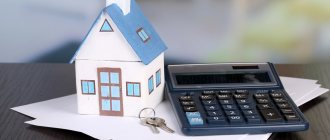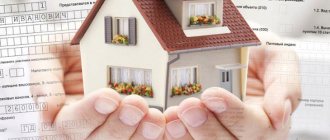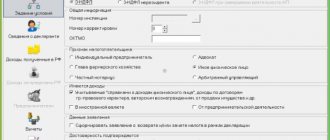In what cases are you entitled to a deduction What can be included in the deduction What cannot be included in the deduction If payment documents are lost When can you apply for a deduction Documents for deduction when building a house Amount of deduction when building a house Did you take out a loan to build a house? House finishing costs
If you built a house, you can get back some of the money spent on construction. It doesn’t matter whether it was your personal savings or borrowed ones. This is stated in paragraphs. 3 and 4 clauses 1 art. 220 Tax Code of the Russian Federation. In the first case, you receive a tax deduction for the construction itself, in the second, you also receive a tax deduction for the interest you paid to the bank for the loan.
In order to receive a property deduction for a built house, a number of conditions must be taken into account.
In what cases are you entitled to a deduction?
1. You purchased a plot of land and built a residential building on it
We are talking specifically about a residential building, and not about a residential building. The Letter of the Federal Tax Service of the Russian Federation dated 02/15/2018 N GD-4-11/ [email protected] “On the procedure for applying the property tax deduction for personal income tax” and the Letter of the Ministry of Finance of Russia dated 02/08/2018 N 03-04-07/7700 states :
“In accordance with the current legislation of the Russian Federation, the terms “residential building” and “residential building” are not identical.”
Thus, from paragraphs. 3 and 4 clauses 1 art. 220 of the Tax Code of the Russian Federation follows:
“...there are no grounds for applying property tax deductions provided for in Article 220 of the Code during the construction or acquisition of a residential building that is not recognized as a residential building.”
It should be taken into account that, according to Letter of the Ministry of Finance of Russia No. 03-04-05/27085 dated 05/03/2017:
“If a residential building is recognized as a residential building, a property tax deduction, the taxpayer has the right to receive the specified tax deductions provided for in subparagraphs 3 and 4 of paragraph 1 of Article 220 of the Code, taking into account the established requirements.”
So, one thing is important for us - you can return the tax if you built a residential building with the right to register in it, registered it with Rosreestr and received an extract about it.
Example:
In 2021, you bought a plot of land for personal subsidiary plots (personal subsidiary plot) and built a house on it. According to the documents, it is registered as a residential building without the right of registration. In this case, you are not entitled to a tax deduction. But if the house is recognized as a residential building with the right to register in it, you can receive a property tax deduction for it.
2. You bought a house under construction and completed it
Attention! If you plan to receive a refund not only for the purchase of the house, but also for its construction, carefully draw up the purchase and sale agreement. It must indicate that you are purchasing an unfinished construction project.
Example:
In a cottage village, a plot of land with an unfinished house was for sale. You have correctly drawn up the purchase and sale agreement and stated that you are buying an unfinished construction project.
After you finish building the house and receive an extract from the Unified State Register of Property Rights, you can submit documents to the tax office. The deduction will include both the costs of purchasing an unfinished house and construction costs.
Example:
You found a house you liked and rebuilt it as you saw fit: you carried out various types of reconstruction, expansion and improvement. Since you purchased a finished house and not an unfinished construction project, you will not be able to include construction costs in your tax deduction.
Legislation
According to the law, a citizen can indicate any amount for building a house:
- Article 220 of the Tax Code of the Russian Federation says that money for the construction of a private house can be returned.
- Federal Law No. 212 regulates the list of persons who may qualify for personal income tax (parents, guardians, children).
- Letter of the Ministry of Finance of Russia dated May 14, 2015 No. 03-04-07/27582 indicates the possibility of receiving deductions by a spouse.
- According to letters from the Ministry of Finance dated May 14, 2015 No. 03-04-07/27582 and dated March 25, 2015 No. 03-04-07/16238, it is possible to receive property compensation to repay loan interest.
Important! The taxpayer should not overestimate or underestimate the amount of deductions: this may result in a fine.
What can be included in the deduction
When applying for a property deduction for building a house, keep in mind that not all of your expenses will be taken into account when returning your personal income tax.
What expenses are deductible:
- acquisition of land for construction;
- purchase of an unfinished construction project (residential building);
- ordering and payment of design and estimate documents;
- connection to general engineering networks and communications: electricity supply, water supply, sewerage, gas supply;
- construction of autonomous networks and communications: electricity supply, water supply, sewerage, gas supply;
- construction/finishing materials;
- construction work and finishing.
Do not forget to save all payment documents for purchasing materials and placing paid orders. It is on the basis of these documents that you will claim your right to a tax refund.
Tips and tricks
Difficulties may arise when filing a property deduction. For example: the recipient of payments is a woman who went on maternity leave. To return the funds, she does not need to go to work; it is enough to give her husband permission and a power of attorney to receive all payments (in case of official marriage). This is feasible if the woman is the owner of the constructed housing.
Another difficulty arises with buildings on summer cottages. The way out of the situation lies in documents where there should not be a “dacha”, “non-residential” building.
All payments should be made out in your name, otherwise it will be impossible to prove that you paid for the money spent.
Attention! If difficulties arise, you can contact accounting firms for help. They will easily prepare and submit all the papers.
It is not difficult to issue a tax deduction, and if you have any questions, you can use the services of a lawyer at the right time.
What cannot be included in the deduction
According to letters from the Ministry of Finance of Russia dated January 20, 2011 No. 03-04-05/9-15; dated August 24, 2010 N 03-04-05/9-492; dated January 20, 2011 N 03-04-05/9-15; dated September 15, 2010 No. 03-04-05/9-545 the tax deduction does not include:
- redevelopment of premises in a built house;
- redevelopment and reconstruction of a built house, including the construction of floors or extensions;
- installation of plumbing, gas and other equipment;
- construction of adjacent buildings: swimming pool, bathhouse, garage, barn, fence, etc.
- a gas boiler;
- air conditioning systems;
- any plumbing equipment: shower, bath, toilet, faucets, water meters;
- production and installation of loggia glazing;
- cost of purchasing plastic windows;
- warm floor;
- sound insulation;
- installation of electrical wiring, telecommunications, computer network and cable television wiring.
Example:
You bought a plot of land with an unfinished house, completed construction and decided to build a swimming pool on the plot. Costs for the pool will not be included in the tax deduction. You will receive a tax refund only for the purchase of land, purchase of a house, construction and decoration.
Information support from a tax expert of the online service NDFLka.ru means a correctly completed 3-NDFL declaration and receiving the maximum possible tax deduction when building a house!
When can you apply for a deduction?
In order to receive a personal income tax refund, you need to contact the tax office. According to paragraphs. 6 clause 3 art. 220 of the Tax Code of the Russian Federation, among other documents, it is necessary to provide an extract from the Unified State Register of Real Estate.
This means that until you have registered title to the house and received a statement, you cannot claim the property deduction.
So, first you need to complete the house, then register it as a residential building (not as a residential building!) and receive a document of ownership. Only after this should you contact the Federal Tax Service at your place of residence.
You can submit a 3-NDFL declaration and an application for a deduction for building a house the next year after receiving an extract from the Unified State Register of Real Estate. In order not to wait for next year, and start receiving a deduction this year, contact the tax office for a notification and apply for a property deduction from your employer.
Example:
In 2021, you bought a plot of land and began building a residential building. In 2022, the construction was completed, in the same year you registered the property rights, about which you received an extract from the Unified State Register of Real Estate. You can send documents to the tax office no earlier than 2023. The month of submission of documents does not matter.
It is not necessary to go to the Federal Tax Service next year. Since the property deduction works without a statute of limitations, you can do it in a year or two. But remember: if you want a refund for past periods, this refund will only apply to the last three years.
Example:
You have received title to your home in 2021. They decided to contact the Federal Tax Service in 2022. You have the right to get a tax refund for 2021, 2020, 2021.
Contact your employer
In addition to payment through the tax office, there is another option for receiving a refund - contacting the employer. Its advantage is that the money will be paid out faster, since this can be done before the end of the tax period for which the refund is made. With this option, the employer will simply stop deducting from the employee’s salary the amount necessary to pay personal income tax.
In any case, you will first need to submit a complete package of documents to the tax office. And when she makes a positive decision on the issue of providing a refund, contact her employer. After this, the tax will no longer be withheld from the next payment. If a citizen works in several places at once, then the tax office needs to take several notifications for them and contact each one separately.
Documents for tax refund when building a house
In most cases, the right to a property deduction applies not only to the purchase and construction of a house, but also to the purchase of a land plot.
All these expenses can be entered into one 3-NDFL declaration. Below we provide a complete list of documents for tax refunds for the purchase of land, houses and construction.
You will need copies of:
- Passport. To check with the Federal Tax Service, you must present the original.
- Extract from the Unified State Register of Real Estate to your home.
- Extract from the Unified State Register of Real Estate for land.
- House purchase and sale agreement.
- Contract of purchase and sale of land.
- Payment documents for the land plot (bank statements, checks, receipts, receipts, etc.).
- Payment documents for the purchase of a home (bank statements, checks, receipts, receipts, etc.).
- Register of construction costs.
- Design and estimate documentation, contract agreements, certificates of completed work.
- Payment documents for all construction and finishing materials (checks, bank statements, receipts, payment receipts).
You will need the originals:
- Declaration 3-NDFL.
- Help 2-NDFL. Obtain from your employer. Required condition: the certificate must be for the year the deduction was issued. If in 2022 you submit a declaration for 2021, the 2-NDFL certificate must be for 2021.
- Application to the tax office for personal income tax refund. Among other data, it indicates the account for transferring money.
If you include mortgage interest in your tax deduction, then attach an agreement with the bank and a certificate from the bank about the interest paid.
The procedure for drawing up and recording a consolidated invoice
So, in order to pass on the input VAT to the investor, the customer must draw up a consolidated invoice. This is done on the basis of invoices received by the customer from suppliers and contractors, and purchased construction and installation works and goods are allocated as a separate item.
It should be noted that the legislation has never introduced such a document as a consolidated invoice. This so-called concept document was proposed by the Ministry of Finance in 2006. Its introduction was caused by a surge in investment activity. And for 10 years now, developers have been drawing up a consolidated invoice to investors in order to transfer the “input” VAT to them.
The consolidated invoice is drawn up in two copies. The first of them is transferred to the investor - it is on its basis that VAT is accepted for deduction. Along with it, the investor must receive copies of invoices that suppliers and contractors issued to the customer, as well as copies of primary documents accompanying the operations. The investor registers a consolidated invoice in the purchase ledger and reflects it in the Journal of Issued and Received Invoices.
As for the customer, he reflects his copy of the consolidated invoice in the first part of the Journal. Please note that this document is not reflected in the sales book.
The customer issues a separate invoice to the investor for the amount of his remuneration - it is not included in the summary document. The developer must reflect this invoice not only in the Invoice Journal, but also in the sales book.
Amount of deduction for building a house
The total amount of property deduction cannot exceed 2 million rubles . This amount includes the purchase of land, the purchase of a house and the construction/repair of an unfinished construction project. The maximum refund is 13% of the tax deduction: 260 thousand rubles = 13% x 2 million rubles.
The tax deduction cannot be greater than the amount of your expenses . If you spent 1.5 million rubles when buying and building a house, then the tax deduction will be 1.5, not 2 million rubles.
The annual refund cannot exceed the amount of income tax you paid . If during the year you did not receive the entire amount, the balance does not expire and is transferred to subsequent years until the allotted amount is completely exhausted.
Example:
You bought a plot and built a house. The total cost was 8 million rubles. Since the maximum amount of property tax deduction is set by law at 2 million rubles, you can receive a refund based on this amount. This means that you will receive 260 thousand rubles into your account.
Important addition! If you are officially married, then your husband/wife can also claim a deduction. As a result, each of you will receive 260 thousand rubles, that is, 520 thousand rubles per family.
Amount of monetary compensation
The maximum amount for which a deduction is granted is 2 million rubles. If expenses exceed this figure, compensation will still be given exactly from 2 million, but if it is lower, then a deduction will be provided from the purchase amount.
The amount for which a deduction from interest on a loan is provided can be a maximum of 3 million rubles. But this should not be confused - this refers to the amount of interest, and not the amount borrowed. For example, if 2.5 million were taken on credit, and the return should be 3.7, then the return is given in the amount of 13% of 1.2 million rubles, and not of 2.5.
There are a couple more nuances regarding the amount of the refund: with shared ownership, the deduction was previously distributed among all shareholders in proportion to their shares. Now each of those receiving a share can apply it separately.
The second significant change is that if previously such a deduction was available only once, now it can be applied several times until the maximum established amount of 260,000 rubles is paid. For example, if the first time a house was built for 1.2 million and the return was 156,000, then during the second construction or purchase of real estate the maximum return could be 104,000 rubles.
Calculation rules
Based on the previously given parameters of monetary compensation, it is not difficult to calculate the amount that will be provided as a deduction - it should be 13% of the amount with which this deduction is provided, since this is the income tax rate. In addition to the previously mentioned restrictions, you should also take into account the fact that no more can be returned than was paid in taxes for the billing period.
Taking all this into account, we will carry out the calculation under the following parameters: 3.8 million rubles were spent on the construction of the house, the salary of the citizen to whom the refund should be made is 50,000 rubles, he has no other sources of income.
The amount for which the deduction is provided is limited to 2 million, which means the maximum refund amount is: 2,000,000 x 0.13 = 260,000 rubles. Receiving 50,000 per month, a citizen has an income of 50,000 x 12 = 600,000 per year, and pays 600,000 x 0.13 = 78,000 from it in the form of personal income tax.
This means that out of the 260,000 due to him for the year, only 78,000 can be returned. This does not mean that he will never receive the remaining amount - in the following tax periods, until the entire amount is repaid, he can continue to receive a deduction.
We have provided a simple calculation without taking into account factors that may affect the amount paid in taxes, and the only source of income is wages - usually there are more factors, and all of them need to be taken into account.
When using credit funds, you will need to calculate another deduction that applies to them and is provided separately from the first.
The maximum amount with which it can be given is 3 million rubles. But this is a deduction from interest. So, if in the case we just considered with the construction of a house for 3.8 million rubles, this money was taken from the bank, and in the end, according to the terms of the agreement, 5.5 million should be returned to him, then the deduction is given from 5,500,000 - 3,800 000 = 1,700,000, which means its amount will be: 1,700,000 x 0.13 = 221,000 rubles - this is exactly how much will be returned to the citizen.
And separately from it, the previously discussed main deduction is also given - there is no need to choose just one, and the main deduction is also given from the funds taken on credit, since they were also spent on construction.
If the construction was only partially financed with loan funds, for example, 3 million was spent on a house, of which 1.5 was taken on credit, a deduction from interest will also be available, but, accordingly, the amount repaid will decrease.
You can apply for a deduction from interest either annually or after completing the loan, for the entire period at once in order to receive the full amount - but in the second case, you need to calculate that tax payments for the year exceed the deduction amount, otherwise you will have to stretch out the return over several years.
Did you take out a loan to build a house? Get a tax deduction on interest
If you used a mortgage loan to buy and build a house, you have the right to return income tax on the interest paid to the bank.
The amount of interest accepted for deduction is 3 million rubles. The calculation includes interest actually paid to the bank.
Keep in mind: Before January 1, 2014, the mortgage interest tax deduction was unlimited. For a house built before this time, you will receive a full deduction for the entire amount of interest paid to the bank.
Important addition! If you are officially married, then your husband/wife can also claim an interest deduction. As a result, each of you can receive up to 390 thousand rubles, that is, up to 720 thousand rubles per family.
Example:
In 2012, you took out a targeted mortgage loan in the amount of 15 million rubles and bought an unfinished house. In November 2014, you completed construction and received a title deed. They decided to apply for the deduction in 2022.
To date, you have paid 4 million rubles in interest to the bank. Since the house was registered before January 1, 2014, you are entitled to a deduction for the entire amount of interest.
Namely: 13% x 4 million rubles. = 520 thousand rubles. If you continue to pay principal and interest, you can take an annual deduction for the interest actually paid during the past year.
Detailed information in the article “Tax deduction when purchasing with a mortgage.”
If the object is being built under an investment agreement
When concluding an investment agreement, tax amounts are presented not to the investor, but to the intermediary (customer), who organizes the construction process. Chapter 21 of the Tax Code does not contain the procedure for applying the deduction when concluding an investment agreement, which gives rise to the existence of different points of view on the very possibility of its application.
Some experts believe that since investment activities are not subject to VAT, the investor does not have the right to deduction. Investors attribute the “input” VAT to the cost of the capital construction project. This position is supported by some courts (resolution of the Federal Antimonopoly Service of the Volga-Vyatka District dated March 10, 2006 in case No. A29-502/2005).
According to another point of view, only the transfer of property that is of an investment nature is not subject to VAT, while construction operations for the implementation of this investment project, which are paid by the investor, are subject to taxation. In accordance with this position, the “input” VAT that the investor transfers to the customer can be deducted.
The customer carrying out activities under an investment agreement is, in fact, an intermediary between the investor and contractors (suppliers). The funds he receives from the investor are a source of targeted financing and are not subject to VAT. However, costs incurred by the customer to contractors and suppliers generally include VAT. When the customer transfers the result of construction to the investor, there is no VAT subject to taxation, since there is no fact of sale (ownership of the constructed object initially belongs to the investor). In this case, the object is transferred at its actual cost, including VAT.
The fact that the tax amounts presented by suppliers and contractors to the developer can be transferred by the latter to the investor is confirmed by the Presidium of the Supreme Arbitration Court of the Russian Federation (resolution dated June 26, 12 in case No. A38-1216/2011). This is done on the basis of a consolidated invoice, which is drawn up by the customer to the investor.









